Masterpieces of world column construction: evolution of a three-way standard, studio cult of JBL
Speakers, which will be discussed, are known for setting a new industry standard in sound recording, and somewhat later in home audio. This development of JBL has become a significant part of the history of not only this company, but also the world recording industry, acoustic design studios and to some extent the history of music.

It will be about one of the most popular line of studio monitors in the entire history of electroacoustics. Evolutionary continuity in it can be traced from the late 60s to the present. In other words, a post about JBL 4310 monitors and developments created on their basis.
Thanks to the solutions implemented in these speakers, by 1977, the vast majority of recording studios in the world used JBL studio monitors. Moreover, according to a Billboard survey, by the end of the 70s, the total number of studios using JBL equipment exceeded the total number of studios using equipment of all other brands.
It all started with the dimensions. By the end of the 60s, the popularity of many genres of rock and pop music grew. In turn, this required expanding the capabilities of recording equipment, increasing the number of studios and improving the quality of recordings.
The capabilities of mixers and their overall dimensions began to grow. In addition, many new devices began to appear in the studios, which also took up a lot of space in the late 60s. And as a result of this whole chain - there was less and less space left for monitors.
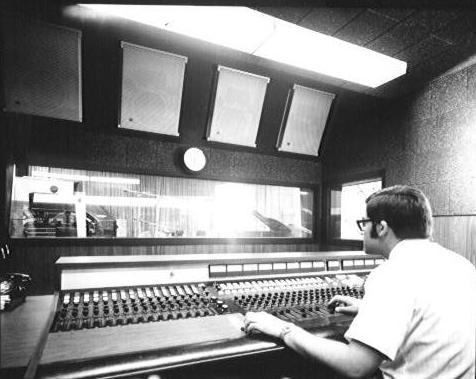
Thus, floor-mounted monitors for studios, which were distributed since the late 50s, should have been a thing of the past, while the fidelity of reproduction, which, as many know, largely depends on the internal volume of the speakers, should have remained the same, and Ideally, get better.
JBL decided that they would be able to realize this seemingly paradoxical task, and in 1968, the development of a new speaker system began. It is known that the engineer Ed Ed May, who owns the concept and adopts the basic technical solutions, became the leading developer of the system.
Also, Bart Locanti, who was engaged in experimental work and measurements, made a great contribution to the creation of the system; for some, computer modeling was used, which is extremely unusual and innovative for the late 60s. The overall management of the project was entrusted to James Barthell. For the appearance of the new system was responsible designer Arnold Wolf.
It is thanks to these key figures in the development team that within one busy and difficult year they managed to realize, without exaggeration, the revolutionary speaker, the JBL 4310.
It should also be noted that an impressive part of the research to create a new speaker was carried out throughout the 60s. A lot of preparatory work was carried out during the development of the JBL 4320 Studio Monitor floor system, which enjoyed serious success in the United States for almost all of the 60s.
 “Dimensionless” and merciless JBL 4320 Studio Monitor
“Dimensionless” and merciless JBL 4320 Studio Monitor
We can say that the mass shelf form factor for studios appeared precisely then and was originally just three-way. The developers quickly realized that the speakers should be smaller in order to place it on the windowsill of the studio window, on the console bridge or suspended from the ceiling. It is important to maintain a wide frequency range and low distortion.
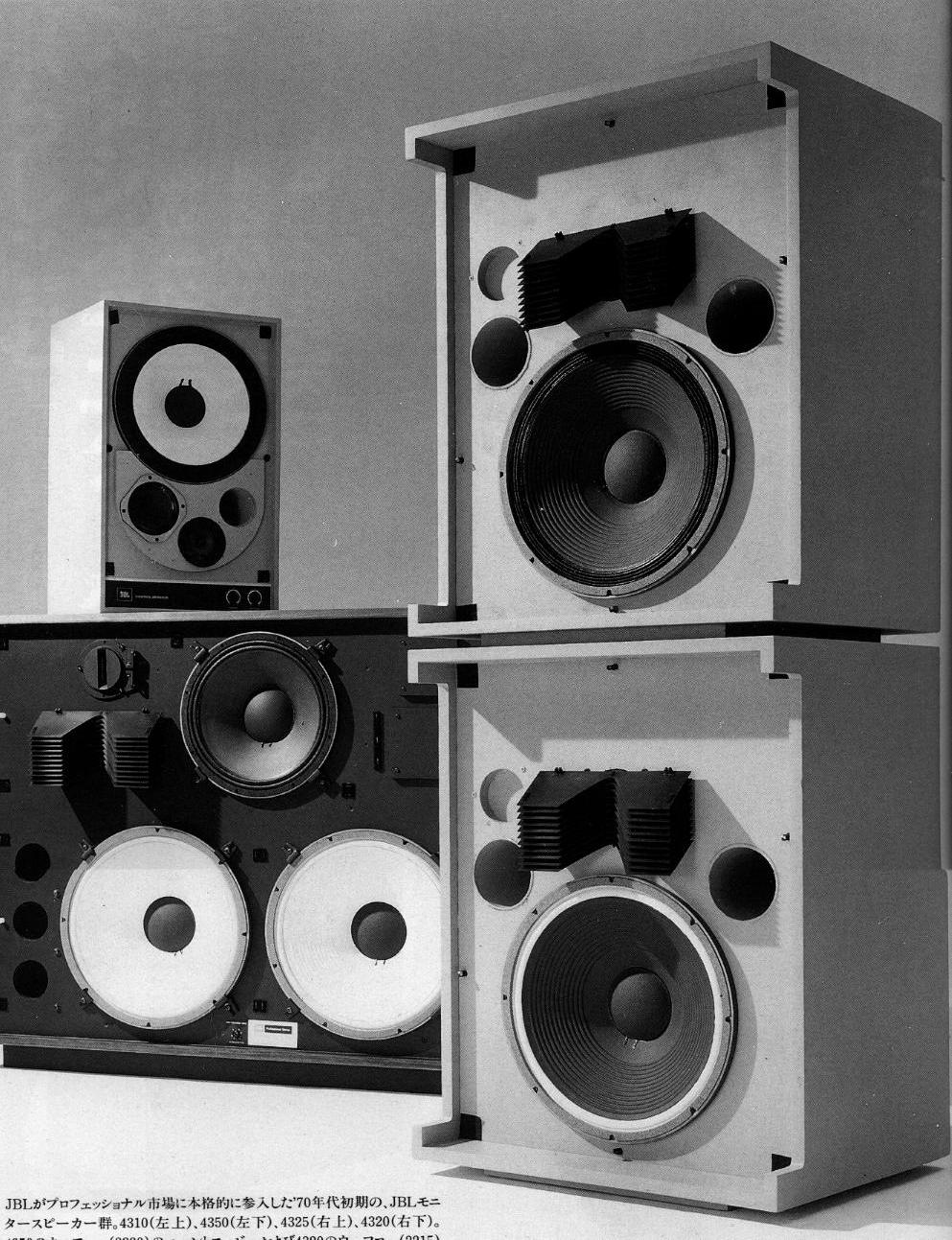 JBL 4310 in comparison with the typical monitors of its time - the beginning of the 70s The
JBL 4310 in comparison with the typical monitors of its time - the beginning of the 70s The
result of many months of “intensiveness” in the development of a new acoustic system were speakers that can be called stretched compact by modern standards. Their overall dimensions were 60 x 36 x 30 cm, a pair of new monitors weighed 23 kg.
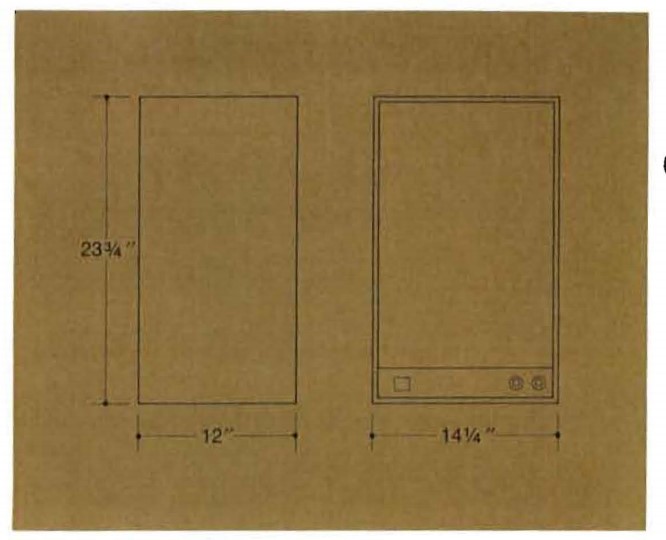
For 1969, they were one of the champions in terms of weight and size characteristics in their power "category" (that is, at 50 watts of program power, with a sensitivity of 45 dB at an input power of 1 mW per 30 feet).
In general, the main characteristics of the monitors were as follows:
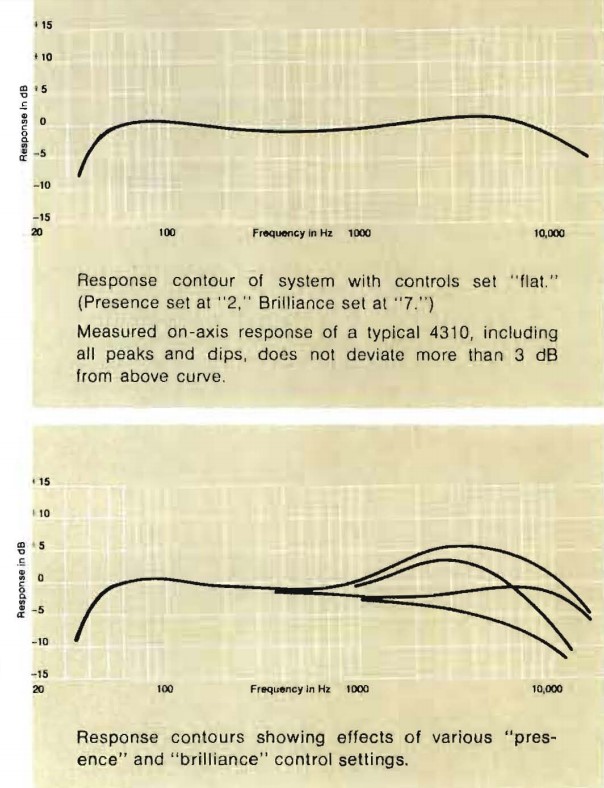
In many ways, this combination of sound and dimensional characteristics was achieved thanks to the use of new speakers with an increased stroke and polymer diffusers that were superior to classical cellulose membranes. Such drivers were the LF - 123A models, the LE5-2 midrange speaker and the LE20 dome tweeter.
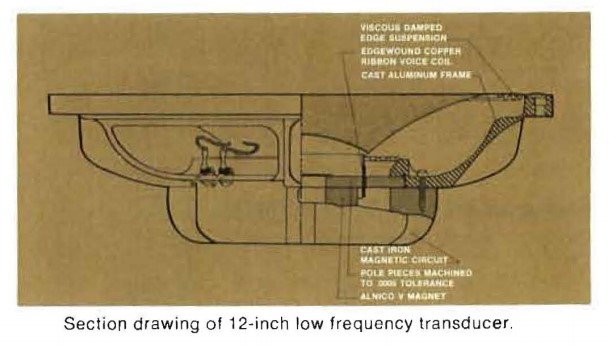
Woofer driver, scheme from the documentation for the system
Almost all well-known sound engineers of that time noted that this particular system is optimal by combining factors such as fidelity, volume, frequency response uniformity, weight and size characteristics, price.
By the beginning of the seventies, the system had won not only the hearts of sound producers, but also audiophiles, who in those years, contrary to some modern ideas, very much quoted monitor acoustics.
A later version, called 4311, changed the tweeter, which was replaced by a smaller block. Removed flat deflectors that did not meet the expectations of the developers. Also, the RF emitter was raised into the acoustic plane of the bass driver, which in those years seemed a more logical solution. In such an improved form, the model will exist along with 4310 until the end of the 70s.
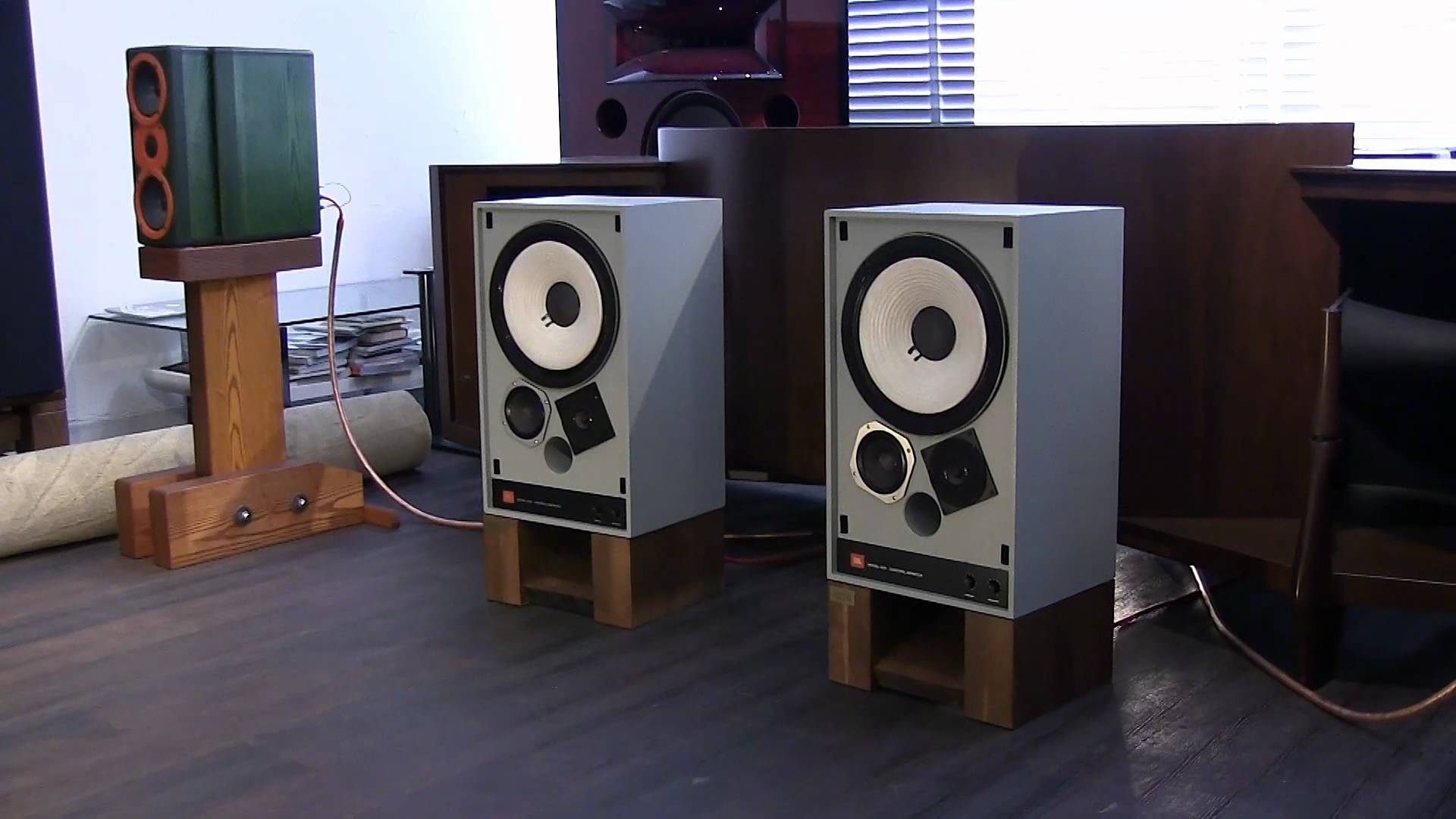 Appearance 4311 The
Appearance 4311 The
interest of non-professionals was fueled by the high demand for monitors in studios, but it is clear that the design of the studio frightened demanding aesthetes with a brutal, especially for the beginning of the 70s, appearance. 4311 did not leave indifferent among music lovers, but most of them wanted to see something more aesthetic as a source of their favorite music.
The peak of popularity of 4310 came at a time when JBL became part of the Jervis corporation, which was controlled by Sydney Harman. To introduce new approaches to promoting products in the consumer market, the latter appointed a talented marketer, Irving Stern. He, in turn, “shamanized” with the design team and turned the 4311 studio monitors into quite aesthetic design speakers, which, among other things, did not lose in acoustic properties. Miracle acoustics for mere mortals was named the L100.
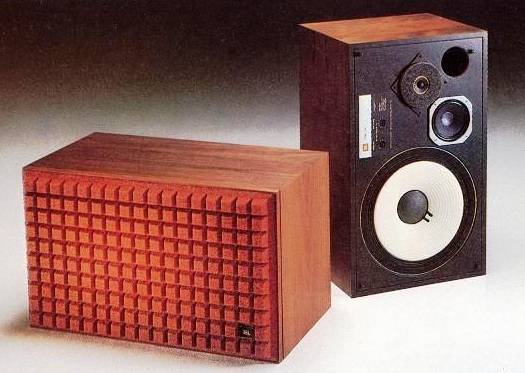
L100
For L100, they simplified the circuitry by eliminating the attenuator control and optimized the acoustic design. In other words, brought in line with the views of the average user. Interestingly, the main characteristics of the device did not suffer from this.
Not without innovation. In order to revive the boring and rude design of the monitors, Arnold Wolf proposed a relief grill. The fabric, traditionally used in such cases, was not suitable for creating a three-dimensional relief.
After a couple of weeks of research, the developers turned their attention to elastic polyurethane foam, as the lightest and acoustically neutral material. So, according to Arnold Wolf, in L100 he was the first to use a foam rubber grill.

The results of the collaboration of designers, engineers and marketers can be evaluated statistically. The L100 became the top-selling speaker system in the US in the 70s.
In the 80s, approaches to music changed once again, studio workers needed a high volume, and, accordingly, the power and sensitivity of monitors. Moreover, over the decade, the technical capabilities of sound-reproducing equipment have grown significantly, and accordingly, the requirements for fidelity of reproduction have grown.
The market and the recording industry were waiting for a new device from JBL, and just as relevant for the 80s as the JBL 4310 at the time. And the JBL engineers once again did this. A new system appeared in 1982 - it was again shelf 3-way monitors, in the forms of which 4310 were clearly guessed.

The new AS was named 4312 and, despite being very reminiscent of its evolutionary ancestor, it was fundamentally new. New monitors received a set of characteristics relevant for that time:
Interestingly, the documentation for the device was supplied with detailed data on frequency and non-linear distortions. Looking at the graphs presented, you understand that many modern speakers (comparable in cost) do not reach the level of 25 years ago. This is probably why some modern manufacturers are not ready to provide detailed measurement results.

Jbl 4312 withstood several reprints. Modifications that had as a basis a single acoustic design could differ in dynamics and crossover elemental base. For example, released in 1982, 4312 was equipped with classic cellulose and cellulose-tissue drivers, and experimental versions 4312 - A, B and BS received a metal dome tweeter (in the case of BS - titanium).
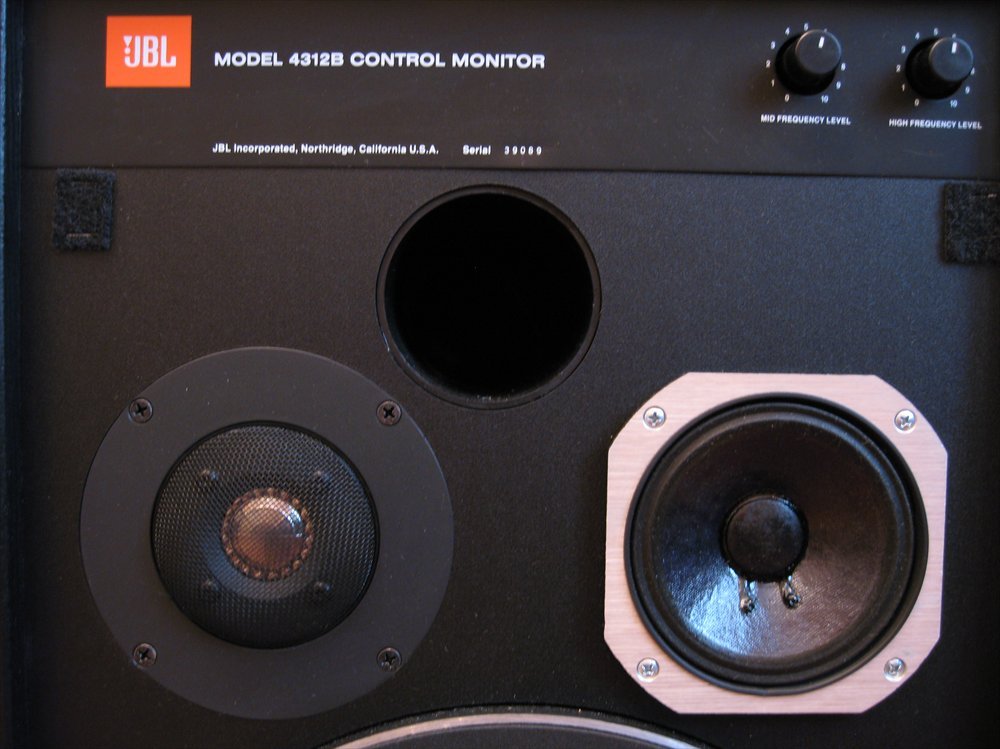
In 2000, the last nostalgic series 4312 mk2 was released with new speakers and an old design and acoustic design.

She kept the titanium tweeter, which turned out to be more tenacious and has a higher fidelity of reproduction.
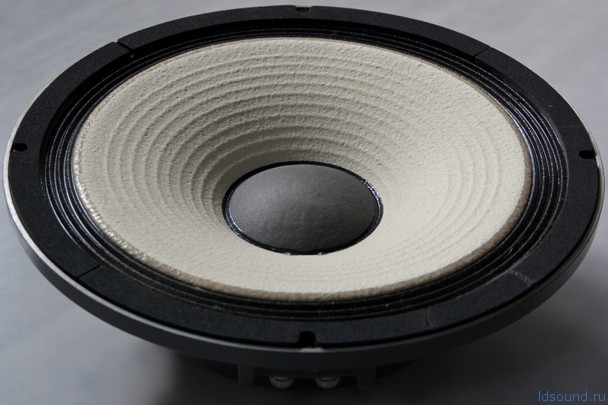
Woofer driver
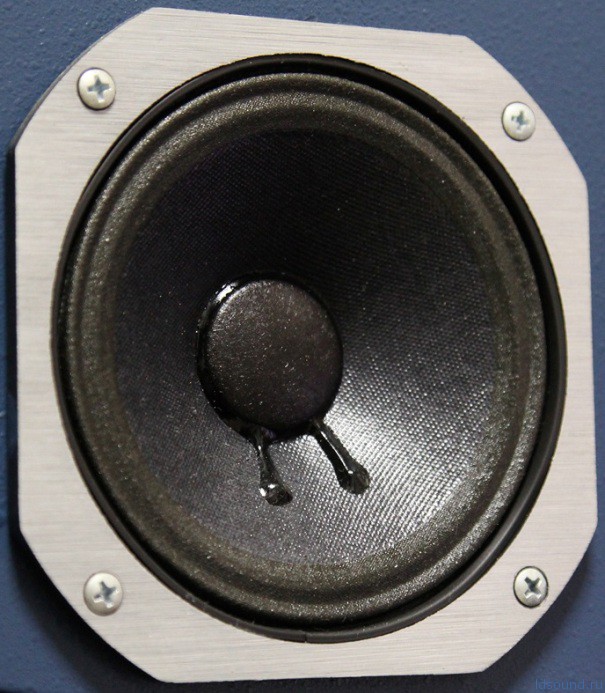
Midrange driver
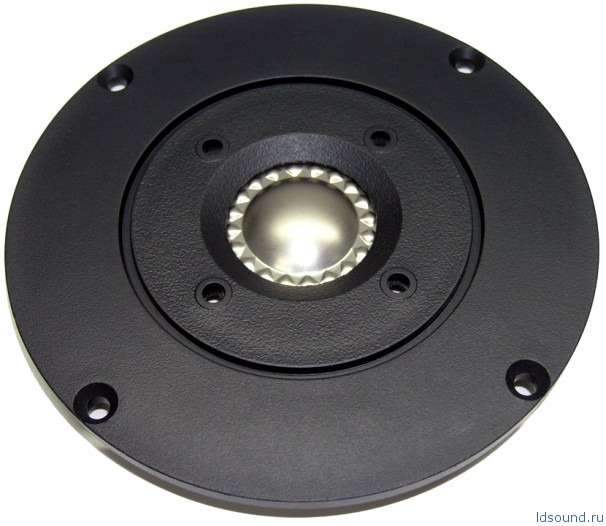
RF emitter
An interesting feature was the filter design, which has changed little since the 80s. Unlike many modern products, they did not save on the element base and ratings. As in the device from the 80s, non-polar capacitors designed for high voltage were used in the filters of the “restyled” version.
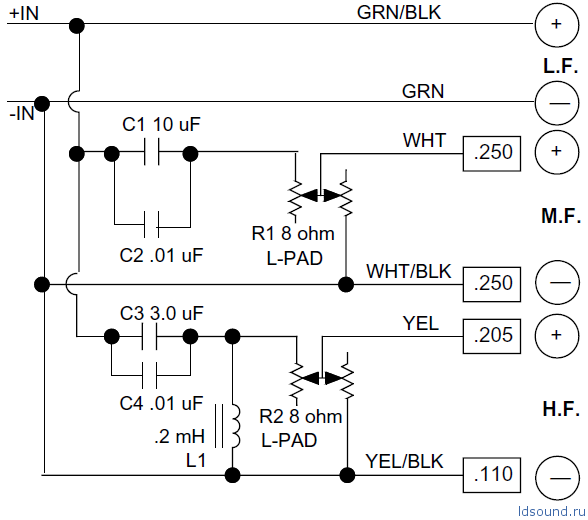
This year, the CES-2108 introduced the updated version of the L100-L100 Classic, which also withstood many reprints.
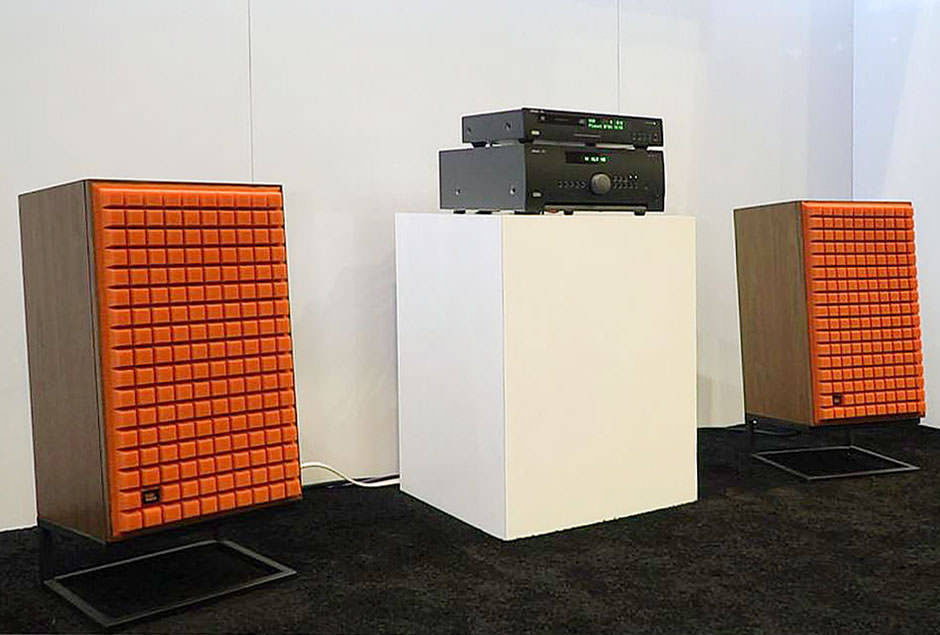
It is known that the engineer Chris Hagen took part in the creation of the remake, who happened to create the recognized cult AC - L100T3 in 1988.
One can argue about which company and which engineer own such inventions as a shelf form factor and three-way separation in monitor acoustics. One thing is clear to me, these two innovations really became widespread after their application in JBL studio monitors. Today 4310 may seem primitive and limited in capabilities, but for their time they were almost flawless.
Photo:
www.audioheritage.org
en.audiofanzine.com
ldsound.ru
roniker.ru
www.troelsgravesen.dk I
highly recommend these information-rich resources to everyone who cares about high fidelity equipment.
Our catalog contains a lot of high fidelity speaker systems

It will be about one of the most popular line of studio monitors in the entire history of electroacoustics. Evolutionary continuity in it can be traced from the late 60s to the present. In other words, a post about JBL 4310 monitors and developments created on their basis.
Thanks to the solutions implemented in these speakers, by 1977, the vast majority of recording studios in the world used JBL studio monitors. Moreover, according to a Billboard survey, by the end of the 70s, the total number of studios using JBL equipment exceeded the total number of studios using equipment of all other brands.
The need for a new form factor
It all started with the dimensions. By the end of the 60s, the popularity of many genres of rock and pop music grew. In turn, this required expanding the capabilities of recording equipment, increasing the number of studios and improving the quality of recordings.
The capabilities of mixers and their overall dimensions began to grow. In addition, many new devices began to appear in the studios, which also took up a lot of space in the late 60s. And as a result of this whole chain - there was less and less space left for monitors.

Thus, floor-mounted monitors for studios, which were distributed since the late 50s, should have been a thing of the past, while the fidelity of reproduction, which, as many know, largely depends on the internal volume of the speakers, should have remained the same, and Ideally, get better.
JBL decided that they would be able to realize this seemingly paradoxical task, and in 1968, the development of a new speaker system began. It is known that the engineer Ed Ed May, who owns the concept and adopts the basic technical solutions, became the leading developer of the system.
Also, Bart Locanti, who was engaged in experimental work and measurements, made a great contribution to the creation of the system; for some, computer modeling was used, which is extremely unusual and innovative for the late 60s. The overall management of the project was entrusted to James Barthell. For the appearance of the new system was responsible designer Arnold Wolf.
It is thanks to these key figures in the development team that within one busy and difficult year they managed to realize, without exaggeration, the revolutionary speaker, the JBL 4310.
It should also be noted that an impressive part of the research to create a new speaker was carried out throughout the 60s. A lot of preparatory work was carried out during the development of the JBL 4320 Studio Monitor floor system, which enjoyed serious success in the United States for almost all of the 60s.

4310 - studio bestseller
We can say that the mass shelf form factor for studios appeared precisely then and was originally just three-way. The developers quickly realized that the speakers should be smaller in order to place it on the windowsill of the studio window, on the console bridge or suspended from the ceiling. It is important to maintain a wide frequency range and low distortion.

result of many months of “intensiveness” in the development of a new acoustic system were speakers that can be called stretched compact by modern standards. Their overall dimensions were 60 x 36 x 30 cm, a pair of new monitors weighed 23 kg.

For 1969, they were one of the champions in terms of weight and size characteristics in their power "category" (that is, at 50 watts of program power, with a sensitivity of 45 dB at an input power of 1 mW per 30 feet).
In general, the main characteristics of the monitors were as follows:
Despite the large (by modern standards) frequency response unevenness (+ -3 dB), this speaker turned out to have a rather smooth schedule. Also a characteristic feature was the extremely low SOI at low frequencies, which was uncharacteristic of the acoustics of that time.
- Software power: 50 W;
- Frequency range: 45-15,000 Hz (+ - 3 dB);
- Crossover separation frequencies: 1500 Hz, 7000 Hz;
- Nominal resistance 8 Ohm;
- Harmonic distortion coefficient: up to 0.8% (1W, 1 kHz), up to 1.5% (100 Hz).

In many ways, this combination of sound and dimensional characteristics was achieved thanks to the use of new speakers with an increased stroke and polymer diffusers that were superior to classical cellulose membranes. Such drivers were the LF - 123A models, the LE5-2 midrange speaker and the LE20 dome tweeter.

Woofer driver, scheme from the documentation for the system
Almost all well-known sound engineers of that time noted that this particular system is optimal by combining factors such as fidelity, volume, frequency response uniformity, weight and size characteristics, price.
Studio hit goes to home
By the beginning of the seventies, the system had won not only the hearts of sound producers, but also audiophiles, who in those years, contrary to some modern ideas, very much quoted monitor acoustics.
A later version, called 4311, changed the tweeter, which was replaced by a smaller block. Removed flat deflectors that did not meet the expectations of the developers. Also, the RF emitter was raised into the acoustic plane of the bass driver, which in those years seemed a more logical solution. In such an improved form, the model will exist along with 4310 until the end of the 70s.

interest of non-professionals was fueled by the high demand for monitors in studios, but it is clear that the design of the studio frightened demanding aesthetes with a brutal, especially for the beginning of the 70s, appearance. 4311 did not leave indifferent among music lovers, but most of them wanted to see something more aesthetic as a source of their favorite music.
The peak of popularity of 4310 came at a time when JBL became part of the Jervis corporation, which was controlled by Sydney Harman. To introduce new approaches to promoting products in the consumer market, the latter appointed a talented marketer, Irving Stern. He, in turn, “shamanized” with the design team and turned the 4311 studio monitors into quite aesthetic design speakers, which, among other things, did not lose in acoustic properties. Miracle acoustics for mere mortals was named the L100.

L100
For L100, they simplified the circuitry by eliminating the attenuator control and optimized the acoustic design. In other words, brought in line with the views of the average user. Interestingly, the main characteristics of the device did not suffer from this.
Not without innovation. In order to revive the boring and rude design of the monitors, Arnold Wolf proposed a relief grill. The fabric, traditionally used in such cases, was not suitable for creating a three-dimensional relief.
After a couple of weeks of research, the developers turned their attention to elastic polyurethane foam, as the lightest and acoustically neutral material. So, according to Arnold Wolf, in L100 he was the first to use a foam rubber grill.

The results of the collaboration of designers, engineers and marketers can be evaluated statistically. The L100 became the top-selling speaker system in the US in the 70s.
1982 - a new stage of evolution - JBL 4312
In the 80s, approaches to music changed once again, studio workers needed a high volume, and, accordingly, the power and sensitivity of monitors. Moreover, over the decade, the technical capabilities of sound-reproducing equipment have grown significantly, and accordingly, the requirements for fidelity of reproduction have grown.
The market and the recording industry were waiting for a new device from JBL, and just as relevant for the 80s as the JBL 4310 at the time. And the JBL engineers once again did this. A new system appeared in 1982 - it was again shelf 3-way monitors, in the forms of which 4310 were clearly guessed.

The new AS was named 4312 and, despite being very reminiscent of its evolutionary ancestor, it was fundamentally new. New monitors received a set of characteristics relevant for that time:
- Software power: 100 W;
- Frequency range: 45 Hz -20 kHz, (+ -3 dB);
- Sensitivity more: 91 dB, 1 W, 1 m;
- Rated impedance: 8 ohms;
- Crossover separation: 1.5 kHz, 7 kHz.
Interestingly, the documentation for the device was supplied with detailed data on frequency and non-linear distortions. Looking at the graphs presented, you understand that many modern speakers (comparable in cost) do not reach the level of 25 years ago. This is probably why some modern manufacturers are not ready to provide detailed measurement results.

Jbl 4312 withstood several reprints. Modifications that had as a basis a single acoustic design could differ in dynamics and crossover elemental base. For example, released in 1982, 4312 was equipped with classic cellulose and cellulose-tissue drivers, and experimental versions 4312 - A, B and BS received a metal dome tweeter (in the case of BS - titanium).

Second birth
In 2000, the last nostalgic series 4312 mk2 was released with new speakers and an old design and acoustic design.

She kept the titanium tweeter, which turned out to be more tenacious and has a higher fidelity of reproduction.
Features of the updated system:
- Frequency range: 45 - 22000 Hz
- Sensitivity: 93 dB (2.83 V / m)
- Recommended Amplifier Power: 150 W
- Rated Impedance: 6 Ohms
- Crossover Frequency: 2000 Hz and 5000 Hz
- Speakers:
- LF: 300 mm (paper on fabric)
- MF: 125 mm (paper on fabric)
- Treble: 25 mm (titanium)
- Finishing options: gray, dark walnut, black
- Lattice color: blue, black
- Dimensions (HxWxD): 597x368 × 298 mm
- Weight: 21.7 kg

Woofer driver

Midrange driver

RF emitter
An interesting feature was the filter design, which has changed little since the 80s. Unlike many modern products, they did not save on the element base and ratings. As in the device from the 80s, non-polar capacitors designed for high voltage were used in the filters of the “restyled” version.

This year, the CES-2108 introduced the updated version of the L100-L100 Classic, which also withstood many reprints.

It is known that the engineer Chris Hagen took part in the creation of the remake, who happened to create the recognized cult AC - L100T3 in 1988.
Total
One can argue about which company and which engineer own such inventions as a shelf form factor and three-way separation in monitor acoustics. One thing is clear to me, these two innovations really became widespread after their application in JBL studio monitors. Today 4310 may seem primitive and limited in capabilities, but for their time they were almost flawless.
Photo:
www.audioheritage.org
en.audiofanzine.com
ldsound.ru
roniker.ru
www.troelsgravesen.dk I
highly recommend these information-rich resources to everyone who cares about high fidelity equipment.
Jeans
Our catalog contains a lot of high fidelity speaker systems
